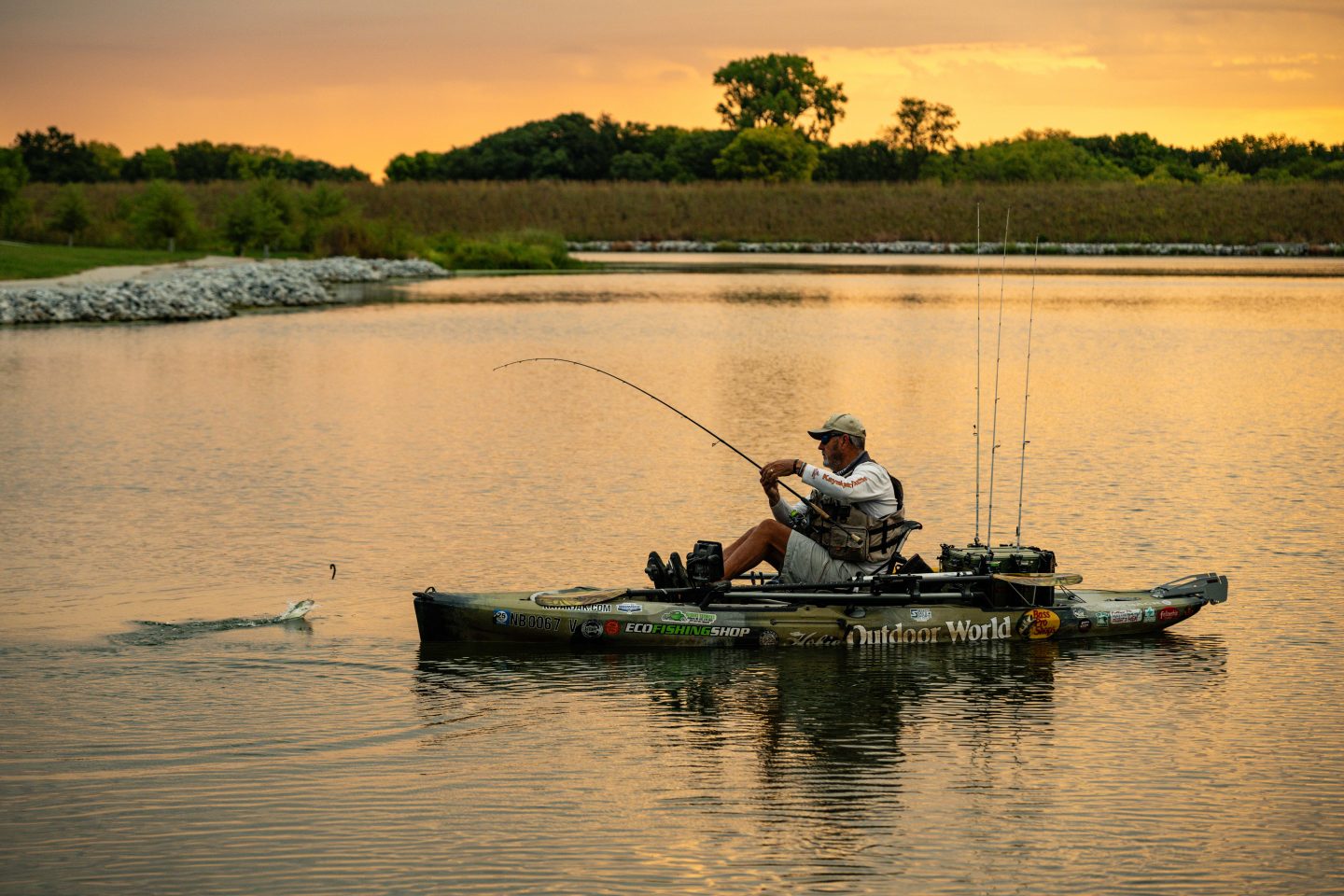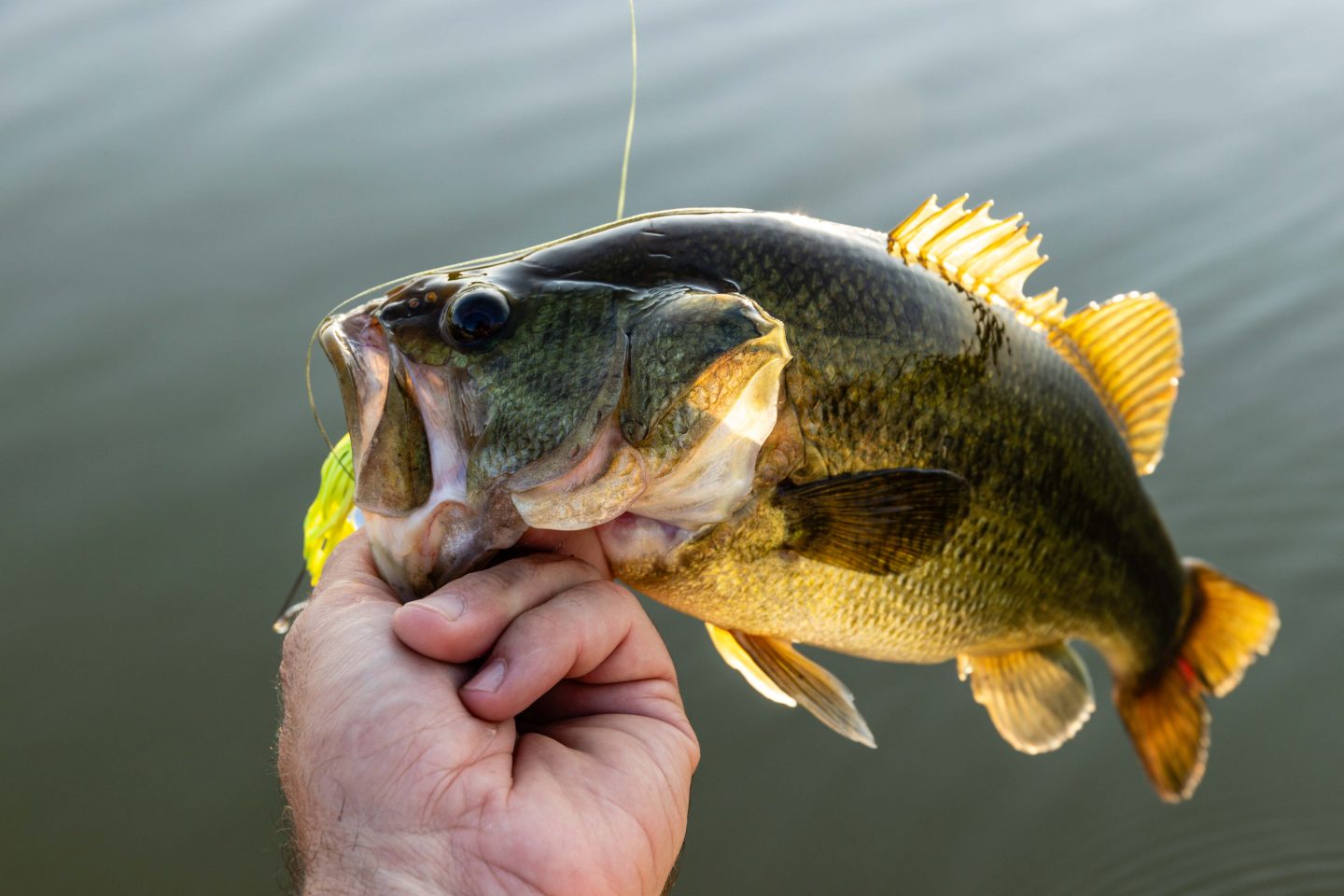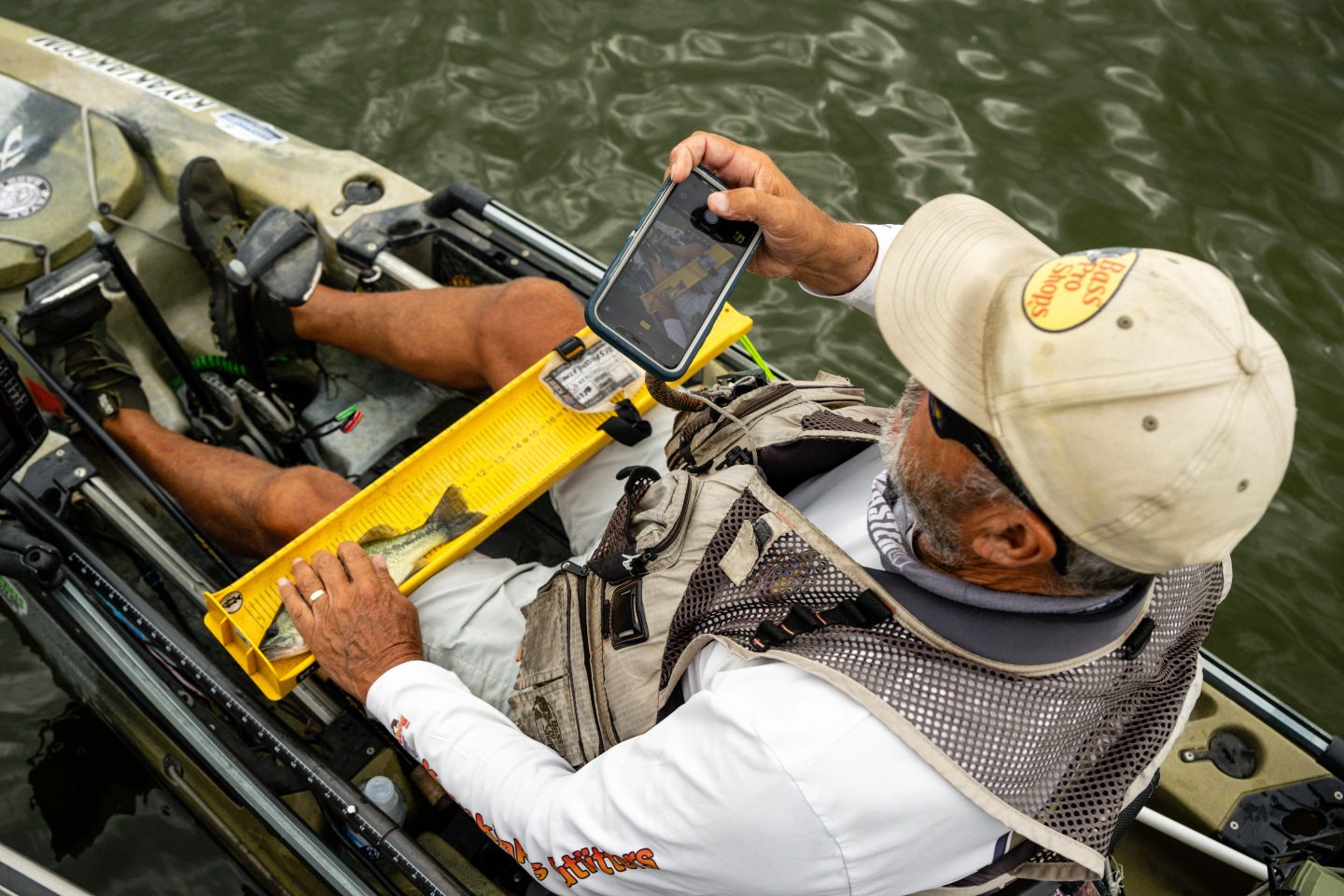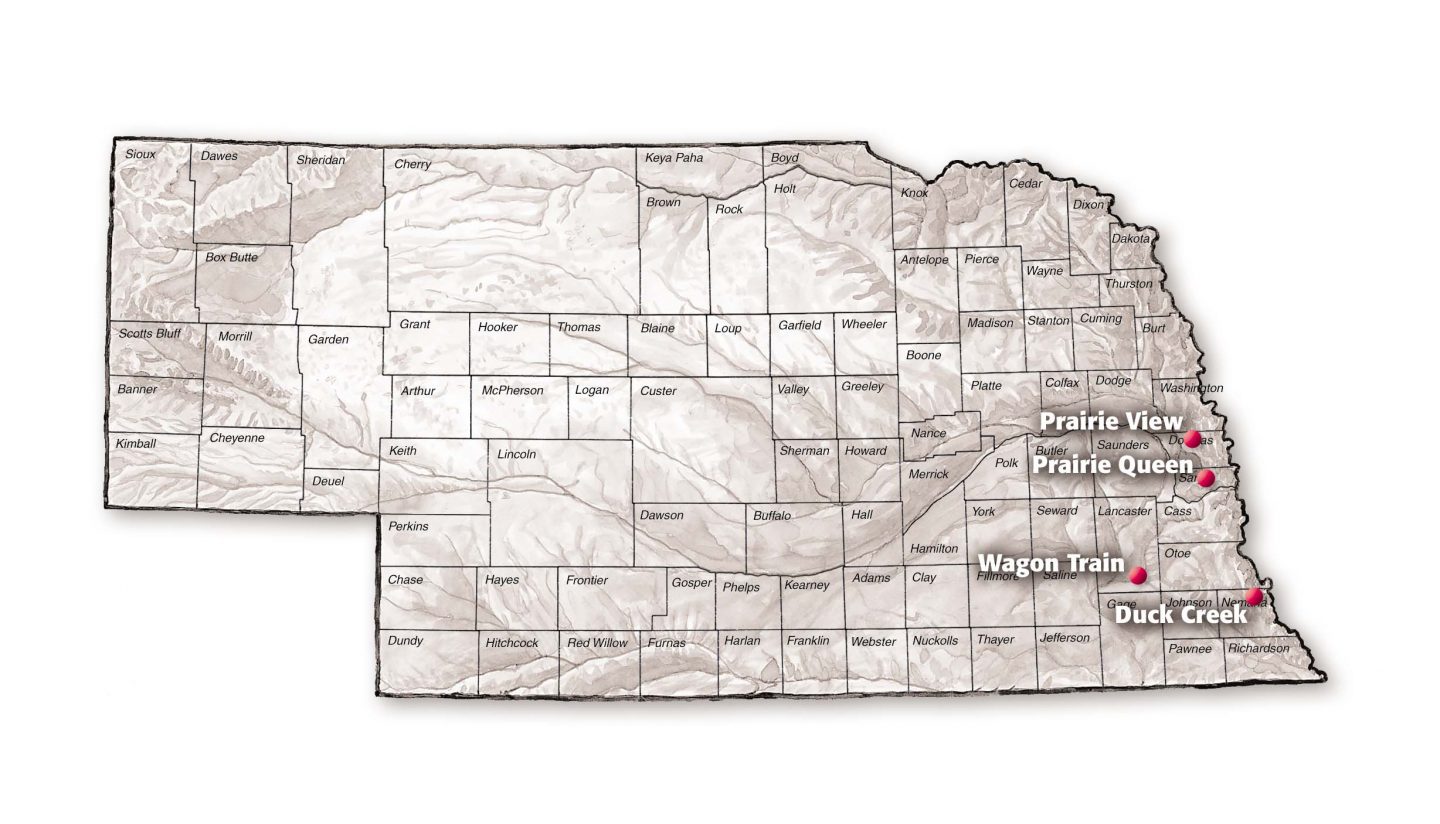
By Eric Fowler
Fisheries biologists are hoping anglers fishing four reservoirs in southeastern Nebraska will go home and have a fish fry after a successful day on the water. And they are hoping largemouth bass will be on the menu.
Bass? What? You can’t keep bass!
Yes, bass. Few anglers harvest bass, thanks to decades of promoting catch-and-release fishing for the species. Yet harvesting small bass, which, at times, have dominated the fish populations at Duck Creek, Prairie Queen, Prairie View and Wagon Train lakes, is what biologists think is needed to produce more big largemouths in those waters.
To facilitate the harvest, a new, experimental protected slot limit goes into effect this year on those four waters requiring anglers to release all bass 15- to 18-inches in length, with only one fish over 18 inches allowed in the bag. The lakes previously had a 21-inch minimum length limit on largemouth bass, a departure from the statewide 15-inch minimum.
Aaron Blank, southeast district fisheries manager, said new or renovated waters are loaded with nutrients and can sustain a lot of fish.
“You get really good year-class strength out of the first stocking, but the problems really begin as you start stacking on multiple year classes,” he said. “This creates an environment with lots of competition for food and typically slows growth rates.”
The result is often lots of bass in the 11- to 14-inch range, with few fish growing to longer lengths, and those taking longer to get there than biologists or anglers would like.

Case Studies
At Prairie Queen, in Papillion, for example, scales collected from bass in 2021 to estimate the age of fish found that, on average, fish didn’t top 15 inches in length until age 6. Blank hopes the new regulation will help fish reach that length a year or two sooner.
In 2022, Wagon Train, located near Hickman, was drained and renovated to remove gizzard shad, white perch and common carp that had found their way into the lake since it was last renovated in 2001. It was restocked in 2022 and 2024, and while drought conditions persist and the lake remains more than 10 feet below normal, when trees and other vegetation that have sprouted from the dry lakebed are flooded, habitat conditions will be as good as they can get for fish.
Wagon Train will be the best test of how the slot limit works on new or renovated lakes. “We have a really good idea of how the bass populations are going to develop over the first four to five years under a 21-inch minimum,” Blank said. “If we can reduce those densities in those early years, we might be able to produce and sustain even more large bass in the five years post-renovation.”
Prairie View, near Bennington, was completed and stocked in 2000. Electrofishing surveys in 2022 showed the lake had a robust bass population, yet while 60 percent of the fish were 12 to 15 inches in length, just 8 percent topped 15 inches. Harvest of bass there will hinge on the success of upcoming efforts to control curly-leaf pondweed, a non-native invasive aquatic plant, that covers the lake by early spring and basically shuts down the lake to fishing.
Prairie Queen and Duck Creek, near Peru, on the other hand, are just about a decade old.
At Prairie Queen, bass densities increased substantially for the first four years. While sampling catch rates declined after 2017, the bass size structure remained fairly constant until 2024, when the number of fish sampled 15 inches or longer jumped from 10 percent to 25 percent. One third of the bass sampled in 2024 were 8 to 12 inches.
Duck Creek also has seen sampling catch rates decline, but not as much. Sampling in 2023 found just 3 percent of the bass topped 15 inches, with 60 percent measuring 8 to 12 inches and another 37 percent 12 to 15 inches.

Angler Perspectives
Marty Hughes can attest to that. The kayak fishing guide and tournament angler moved to Auburn in 2017 and started fishing Duck Creek as soon as it opened the following spring. “We had incredible days that first and second year fishing out here,” he said. “It was really good. There were a lot of 15- to 17-inch bass.”
Hughes has organized adult and youth kayak fishing leagues for several years, during which anglers measure every fish they catch. Those numbers show the same trend as the electrofishing survey data. In 2024, 11 percent of fish caught during events were longer than 15 inches and 60 percent were in the 12- to 13-inch range.
Hughes and anglers he fishes with still catch an occasional 18- to 20-inch fish. But he believes there should be more and hopes the new regulation will help produce them. “I think it’s a good idea because here you have this incredible fishery with lots of little bass,” he said. “I fish a lot of Nebraska lakes, and Duck Creek has the habitat to grow huge bass, and it’s not happening.”
Blank thinks the slot limit will do just that, but noted managing waters with bass and panfish can be a balancing act as a lake can only support so many pounds of either type of fish; sometimes it’s a choice of having big bass or big panfish.
Big Bass or Big Panfish?
The hordes of small bass commonly found in newly renovated lakes are good at thinning out the annual crop of bluegills and crappies. This leaves more food for and leads to faster growth of the panfish that survive the gauntlet. Imposing a 21-inch minimum length limit on these waters to help maintain higher bass densities has been the norm, providing anglers the chance to catch large panfish and high catch rates of bass, Blank said.
Bass densities decline as lakes age, but the goal of fisheries managers is to have 30 percent of the bass 15 inches or longer. In this scenario, however, a lake can end up with lots of small panfish due to the optimum foraging theory and propensity of big fish to eat big fish. “A 4-pounder has no problem eating an 8-inch bluegill,” Blank said. “They’re not going to eat a lot of age 1 bluegills. It doesn’t make sense for them if they can get four times the food and nutrients with four times less effort.”
So while it is not the norm, Blank hopes they can maintain the already quality panfish populations in these lakes while also having bigger bass. “I think we can do both,” he said. To make sure they’re on track, fisheries biologists plan to intensively sample the lakes to get population estimates, while also conducting repeat surveys to measure the response.

Culture of Bass Catch-and-Release
For the most part, a 21-inch minimum length limit on Nebraska lakes has acted as a total catch-and-release regulation for bass, with only trophy bass being kept to mount. Creel surveys conducted at nine southeastern Nebraska reservoirs with the regulation in place found just 547 of 131,910 bass caught were harvested.
The number harvested might not have been much higher without the regulation. Creel surveys at two other southeastern reservoirs with a 15-inch minimum between 2014 and 2019 found only 1.4 percent of the 11,800 bass caught were kept.
That could be attributed to Ray Scott, bass fishing tournament pioneer and the founder of the Bass Anglers Sportsman’s Society. In 1972, he began incentivizing anglers in his tournaments to have live wells so fish could be released after weigh-ins. That conservation-minded incentive led to catch-and-release being the norm for the majority of bass anglers. Tournament anglers now release 95 percent of the fish they catch, and some have never taken a bass home for dinner.
The mentality has also led to lakes with stunted bass populations in places besides Nebraska. In 2022, Oklahoma changed its statewide bass size limit from a 14-inch minimum length to one fish over 16 inches. Their goal was the same as it is for the new regulation on four Nebraska lakes: That anglers would dial back their catch-and-release ethic and harvest the small bass dominating most of their waters in order to allow more bass to get bigger.
“Not every bass has the genetics to be a 20-inch fish, and that’s not necessarily the goal for this regulation,” Blank said. “What we want to do is shift the size a couple of inches so instead of catching 12- or 13- inch fish, we’re catching 15- or 16-inch fish.”
If harvesting bass helps make that happen, it will lead to better fisheries and better angling opportunities.
An Experiment at Four Locations
These four “experimental” waterbodies are requiring anglers to release all bass 15- to 18-inches in length, with only one fish over 18 inches allowed to keep (previously it was 21 inches at these lakes).
For the rest of the state’s waters, it remains a 15-inch minimum.

Parmesan Bass Recipe
By Jenny Nguyen-Wheatley
In a wide, shallow bowl, combine 1⁄3 cup Progresso Italian-style breadcrumbs and 3 tablespoons of grated Parmesan cheese. In a second bowl, beat 1 egg and 1 tablespoon of milk. In a third bowl, add 1⁄4 cup of all-purpose flour. Preheat vegetable oil to 325-350 degrees F. Coat fish in this order: flour — shaking off excess, egg mixture and then breadcrumb mixture. Multiply coating ingredients as needed. Deep fry coated fish in batches until golden and crispy. Season with salt to taste.
